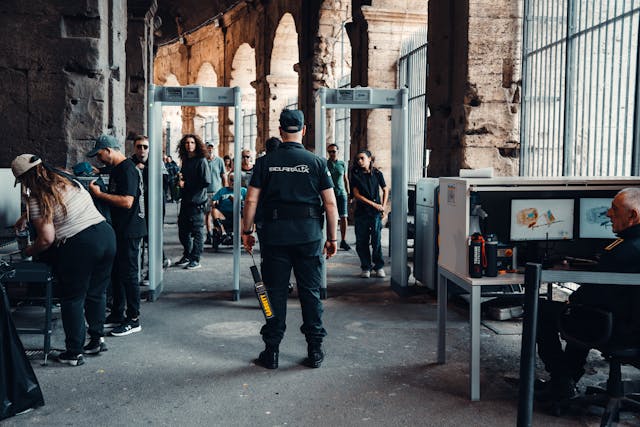
How does an airport metal detector work? An airport metal detector works by creating an electromagnetic field that gets disrupted by any metal objects that pass through it.
A metal detector in an airport can do its job because metal can be induced to produce an electromagnetic field, and bone, flesh, and the water in our bodies can’t. An electromagnetic field is a physical thing made of a combination of an electric field and a magnetic field. It is a physical thing because it can interact with other objects, but you generally cannot see an electromagnetic field. An electromagnetic field is produced when there is a moving electric charge travelling through a material. The field extends out relative to the strength of the electric current. For example, if your TV is switched off, there is a charge in the cable, but it is not moving, so there is no electromagnetic field. When you turn the TV on, the charge starts moving, and an electromagnetic field is produced. The speed which an electric current can move through an object depends on its conductivity, and metal is far more conductive than bone, flesh, and water. That means any metal a person is carrying will produce a greater electromagnetic field than the rest of their body.
An airport metal detector is a frame that you walk through after you have unloaded all of your metal items into the X-ray bins. It uses an electromagnetic field to check for metal. One side of the frame of the detector has coils of wire that can be charged very quickly and a receiver. When a current is sent through the coil of wire, it creates an electromagnetic field that is cast out into the area people walk through. When the current is turned off, the electromagnetic field collapses and sends an electrical signal through the receiver. These pulses are very fast and vary depending on the sensitivity of the metal detector. They can be from as few as 100 a second to over 1,000 a second. The computer in the metal detector sees how long it takes for the signal to return. If there is no metal in the detector, the signal will return as normal, and that is the baseline. If the person going through the detector has any metal on them, the electromagnetic field from the detector will enter the metal, excite the atoms in it, and that will produce an electromagnetic field from the metal. This will add to the detector’s electromagnetic field, and when the power for the pulse is switched off, it will take slightly longer for the electrical signal to reach the receiver. The computer compares this time difference to the baseline and triggers the detector’s alarm.
The metal detector can tell the presence of metal, but it cannot tell the operator what metal or where it is. That falls to a security employee with a handheld metal detector. The handheld metal detector works in a similar way, but it is smaller and more precise. It produces an electromagnetic field, and if it encounters metal, it produces an electromagnetic field in the metal, and the detector can pick that up. Because the device is small and the operator knows where it is when the alarm is triggered, they can then use their hands to find what the metal object is.
The problem with any kind of detector like this is that they can only detect metal objects. A plastic gun or a ceramic knife wouldn’t trigger them. Plastic and ceramic are not electrically conductive, so they don’t produce an electromagnetic field when they come into contact with the field from the metal detector. Because of this, many airports are moving away from simple metal detectors to full-body scanners. These have been rolled out in a lot of airports, and they either use X-ray technology or something similar to produce a full-body image of the passenger. The X-rays won’t be able to penetrate harder things, such as a gun, which makes it better than a metal detector. The problem with these machines is that they subject people to a dose of radiation, and there is no consensus on whether it is a safe dose or not. A lot of detectors use millimeter-wave radar, which are harmful radio waves, to detect objects. There is another method that detects body heat and uses that to analyze what a person might be holding. If you have a gun under your shirt, it is going to be colder and appear darker than your body itself. As of yet, there is no foolproof and unbeatable technology that can be used in airports. And this is what I learned today.
Sources
https://garrett.com/blog/metal-detectors-in-airports
https://science.howstuffworks.com/transport/flight/modern/airport-security3.htm
https://garrett.com/blog/2024/08/01/does-titanium-set-off-metal-detectors
https://www.jeic-emf.jp/english/public/story/around/e-waves.html
https://en.wikipedia.org/wiki/Electromagnetic_field
https://en.wikipedia.org/wiki/Full_body_scanner
Photo by HAMZA YAICH: https://www.pexels.com/photo/security-checkpoint-at-historical-landmark-32027096/
